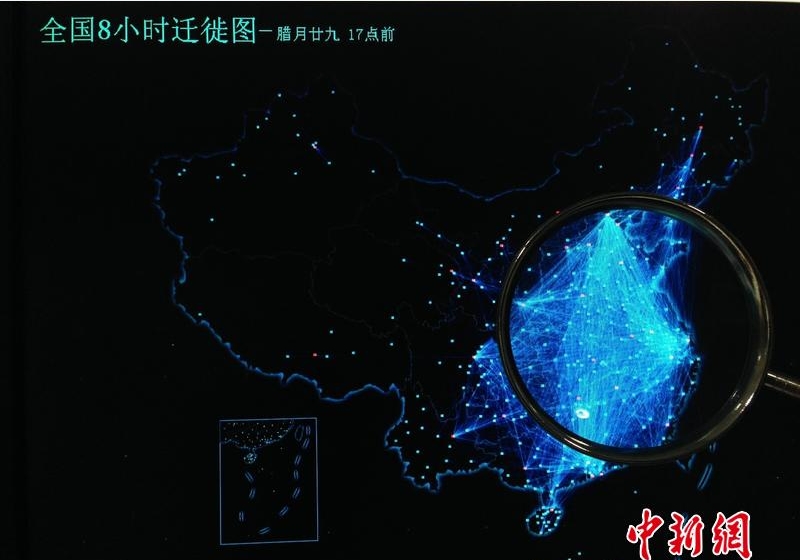Data journalism makes news out of numbers

'Spring Festival Transportation" launched by CCTV using data from the search engine Baidu to show domestic migration patterns of people travelling during the holiday
During the recent Spring Festival holiday period, CCTV launched a special program called "Spring Festival Transportation". Using data from the search engine Baidu to show domestic migration patterns of people travelling during the holiday, the program piqued viewers' interest nationwide. The advent and increasingly wide use of big data has given rise to a new method of reporting—data journalism. This novel reporting tool is able to satisfy viewer demand for comprehensive coverage of society. However, once again calling everyone’s attention to big data, data journalism itself may very well be the biggest news.
Baidu also put up its own program online to show travel patterns during the Spring Festival holiday. Updated every eight hours, the "Migration Map of Spring Festival Transportation" showed the ten cities or locations the most people were arriving to, the ten cities or locations the most people were departing from, and the ten routes with the most travelers in transit. The map was composed using mobile location based services, from which Baidu was able to analyze information on users' location and, by processing this vast data, generate statistics on the population's migration trends.
CCTV-1 also used data from this website to report on travel patterns, including new phenomena such as "reverse migration". Compared with conventional reporting methods, this new style makes use of an incredible amount of information, covering events much more comprehensively. Sun Jianjun, director of the School of Information Management at Nanjing University, clarified that the term "big data" has two key connotations. First, big data is a type of resource, an "artificial resource" that emerges from human activity and will influence human activity in the future. Secondly, big data is an application that can improve our current thinking pattern and observational capabilities.
In actuality, data services provided by news agencies have existed for a while. In China, for instance, websites often use forms of data journalism when reporting important events such as the U.S. presidential election or natural disasters.
"Data journalism is to use big data on a higher level," remarked Shi Guangshun, an associate professor from the College of Computer and Control Engineering at Nankai University. According to Shi, what separates big data from traditional data is that where the former provides information in a type of post-event summary like a numerical statement, the latter, in the sense that it is used today, is immediate and vivid.
Sun Jianjun was quick to point out the limitations of data journalism, however. He observed that while it is an excellent tool for discerning issues, it is seldom able to provide a rational explanation for these issues, let alone offer targeted solutions. Another problem is simply the homogenous nature of cluster analysis, which is unable to register individual features. For the humanities and social sciences, which often focus on individuals, this can be severely limiting.
Big data not only provides new tool for journalists; it is changing the way journalism itself is conducted, as well as academic research on the media. Shen Hao, a professor from the School of Journalism at Communication University of China, pointed out that an important feature of data journalism is how it presents big data visually. In short, data journalists need to delve into, analyze and visualize the data. Their role extends beyond that of conventional journalists and threatens to make traditional reporters obsolete, since a skilled data journalist has to be good at reporting news but also needs to know how to mine data for a newsworthy story.
Jiang Qiping, secretary general of the Center for Informatization Study at the Chinese Academy of Social Sciences, explained that before the advent of big data, data users had to aggregate different sets of data from individual surveys or studies themselves. With big data, however, users can investigate an entire sample at once. This enables the user to see clearly which facts are more representative, which is particularly significant for news reporting because the facts of an event are being covered more immediately, Jiang said.
Journalism is just one field where the application of big data has tremendous potential. Scholars in various disciplines in the humanities and social sciences, including historiography, literature and law, have already been making abundant use of data analysis. This is gradually changing people's understanding of the humanities and social sciences.
The Chinese version appeared in Chinese Social Sciences Today, No. 560, February 17, 2014
Translated by Jing Hong
Revised by Charles Horne
